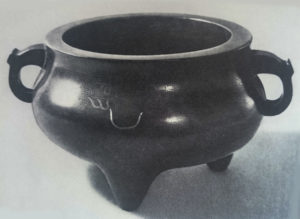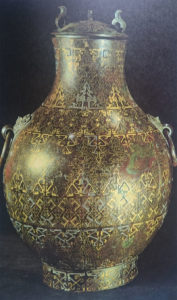
THE MOST difficult problem in the study of medieval Chinese bronzecraft, over a period embracing the Song (960–1279), Yuan (1271 to 1368 AD) and Ming (1368 to 1644) dynasties, is the dating of archaistic work.
These pieces copy ancient bronze vessels, cherished by Chinese connaisseurs of Antique artifacts for their antiquity, and more especially by their ritual purposes.
They are described in the ancient ritual manuals, which to Confucians* ( Confucians were the followers of a tradition, a philosophy of humanistic or rationalistic religion based on the teachings of the Chinese philosopher Confucius 551–479 BCE) were almost sacred texts. the adaptations of ancient decorative motifs came to permeate much of Chinese art.
The archaistic style bore a highly respected symbolism.
Both in China and the West, bronzes now recognizable as medieval were still accepted as ancient, alongside true products of the Shang the earliest ruling dynasty of China, which ruled from 1600 to 1046 BC., and zhou periods (zhou dynasty followed Shang Dynasty and ruled from 1046 until 771 BC ).
The shapes and ornament of ancient vessels were imitated through history of Chinese art. It was the effort to imitate even the accidental effects of patina on bronze vessels recovered from tombs that lead to the techniques
of variegating the colour of the metal, a special feature of the later Chinese bronze craft.
The antiquarian interest to which such copies of the antique appealed was stimulated by the revival of Confucianism in the later, or Southern, Song period.
We are at present on good ground in distinguishing Ming and Qing bronzes from those of the preceding two dynasties, but the distinction between Song and Yuan remains speculative.
PRE-MING Bronzes
Some evidence for pre-Ming date is furnished by the ingredients of the alloy. By early Ming times the use of zinc in good quantities was established. While it is not known when the deliberate addition of zinc to the metal began, it may be presumed that its presence in a large proportion (more, say, than 8 or 9%) is an indication of Ming or later date. On the other hand many post-Yuan bronzes were cast with tin only.
**Among the bronze vessel types of established Ming date are those of the characteristic Hsuan Te style

Those with Arabic descriptions pieces with ornament of identifiable later style and pieces dated by the maker’s signature , such as the work of Hu Wen-Ming . When these are eliminated there remains to be considered an important group of bronzes, of the highest quality, in which the ornament is inlaid in gold and silver with great fidelity to ancient designs (see example below)

It is among those that pieces representing the first flush of Song antiquarian metalwork must be preserved.
It is noticeable that the ornament copies that of the late Zhou and early Han periods, rather than earlier styles which through their association with Shang dynasty and the early Chou kings would be expected to commend themselves more strongly to Confucian antiquarians and collectors. It is significant therefore that Chao Hsi-ku says that in his time inlaid bronze was mistakenly held to be of Shang date.
MING BRONZES
Ming bronzes were often inlaid with silver wire which was inserted into deeply cut grooves in the manner first found in the first half of the 14th century.
In bronzes, as in porcelain vessels which were made in the 16th century contained large decorative inscriptions in Arabic script perhaps through the influence of Muslim eunuchs employed. The vessels can have reddish
colour after casting, in the manner employed in the Hsuan Te period.
In the Ming period interest focuses on a large group of palace bronzes, bearing the mark of the Hsuan Te reign (1426-1435), which introduce new shapes and new methods of variegating the surface of the metal.
As happened also with the Hsuan Te imperial blue-and-white porcelain, the bronzes of this reign acquired such fame that they were imitated for long afterwards, the reign mark cast on them proclaiming their style rather than their date of manufacture.

In our shop we have a Chinese Bronze Snuff bottle with Coral top dated around the end of the 19th century Late Qing (C.1890s), which is a rare, of high quality and a very collectable item.
The bottle is signed by, we believe, a well known Chinese artist Nei Wu Fu Zoo.
Size: 10cm (with top) x 4cm x 2 cm. Weight: 138 g.
This superb quality snuff bottle will adorn any Asian Chinese
Art collection or will make a super present.

Chinese Bronze Snuff Bottle
Chinese Bronze Snuff Bottle with a Coral top by Nei Wu Fu Zoo.
£900.00
- USD: $1,252.24
- EUR: € 1,041.32
Please watch the video ” Antique Chinese Bronze Snuff Bottle”


